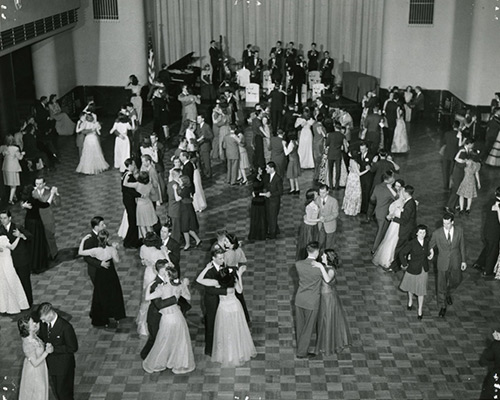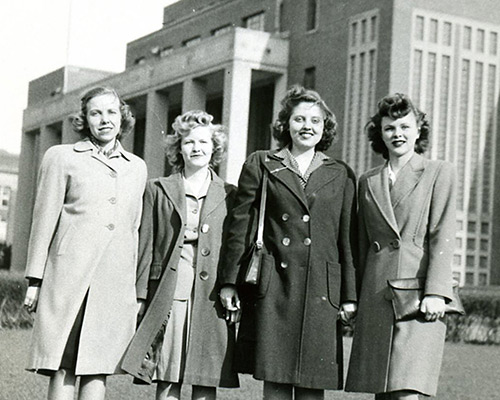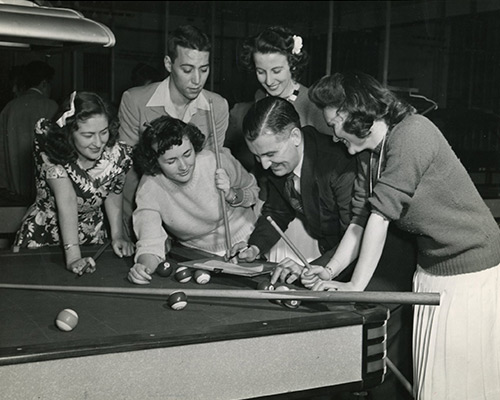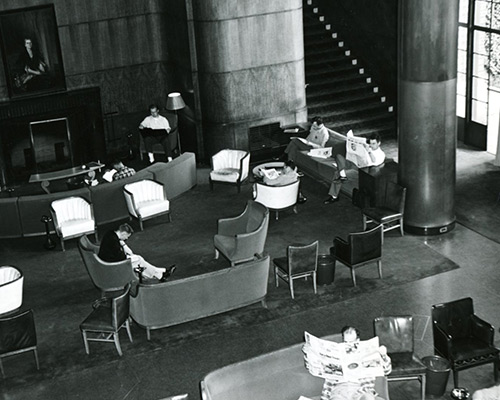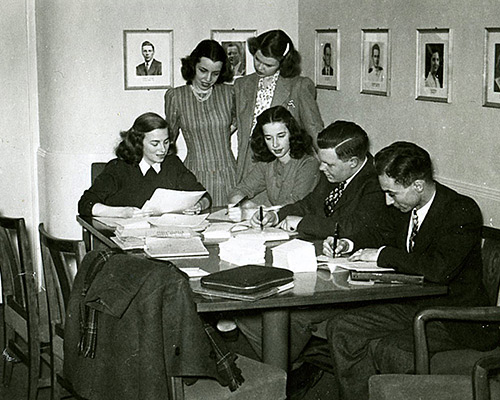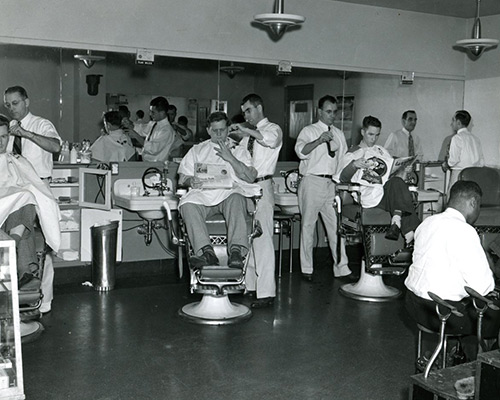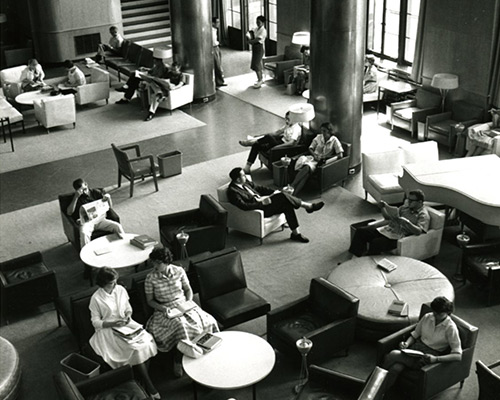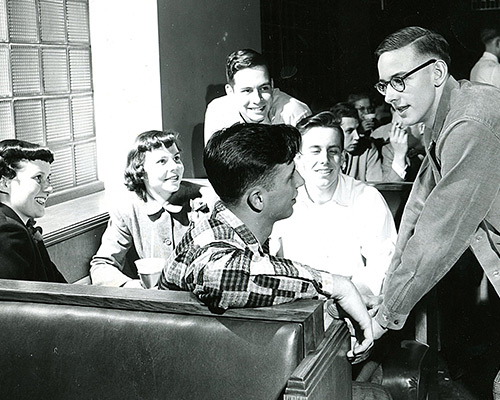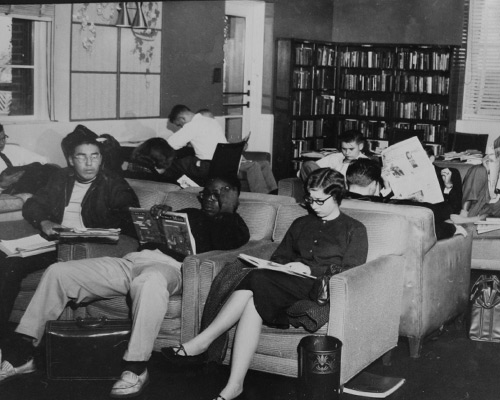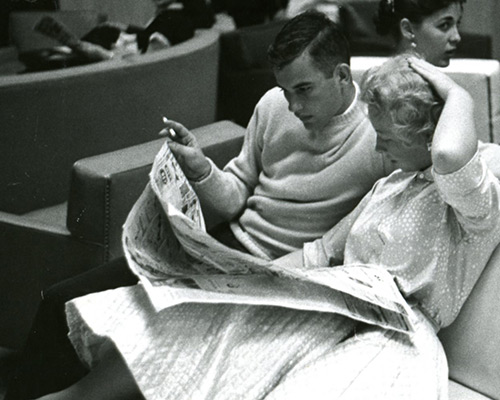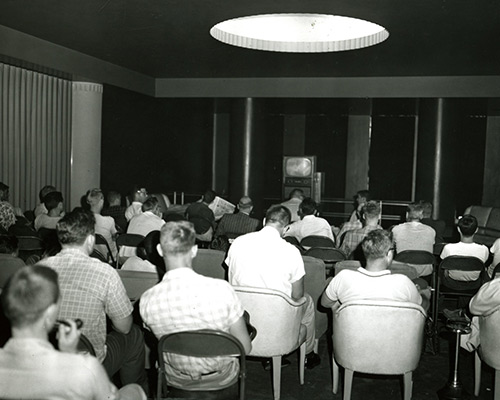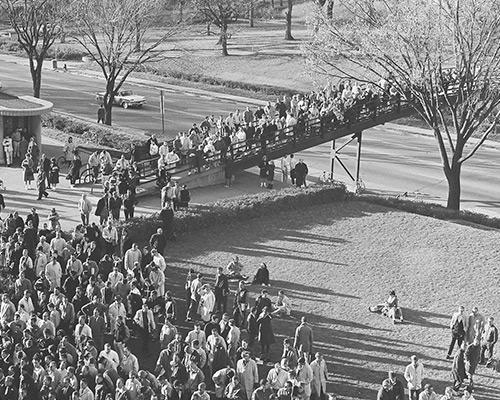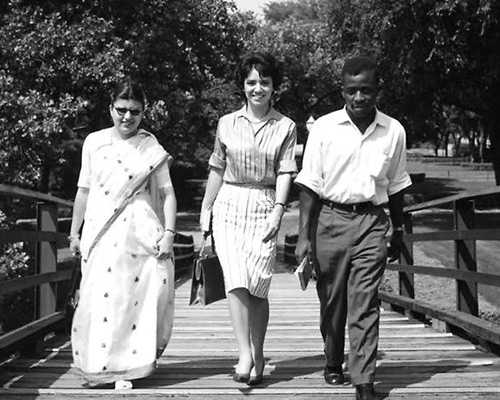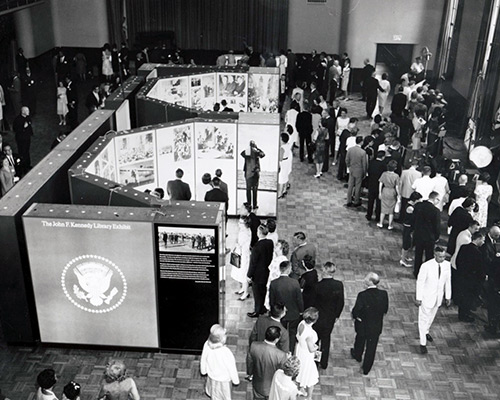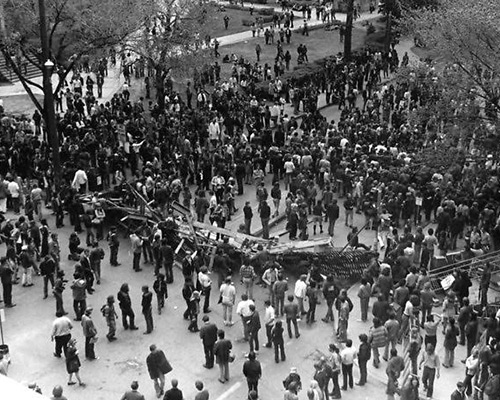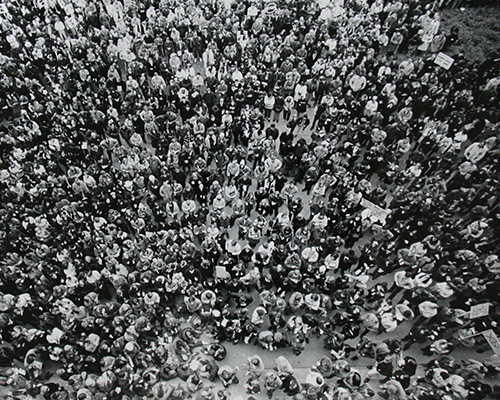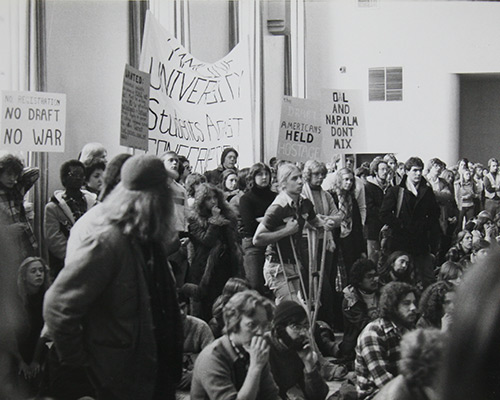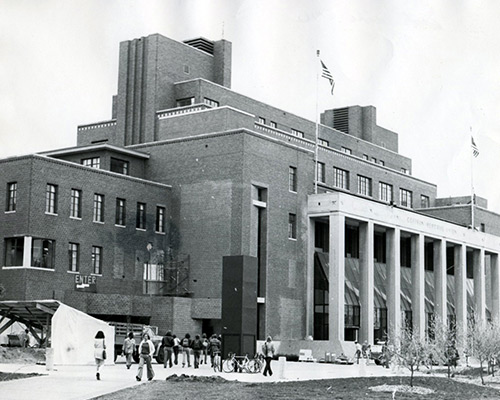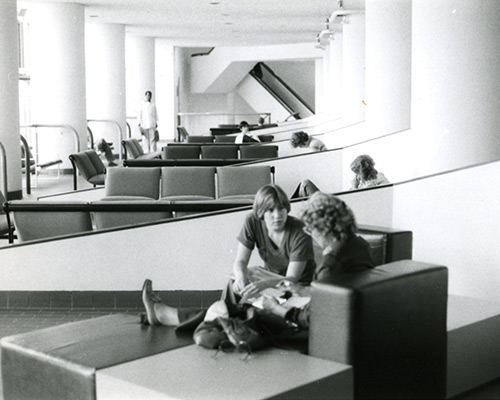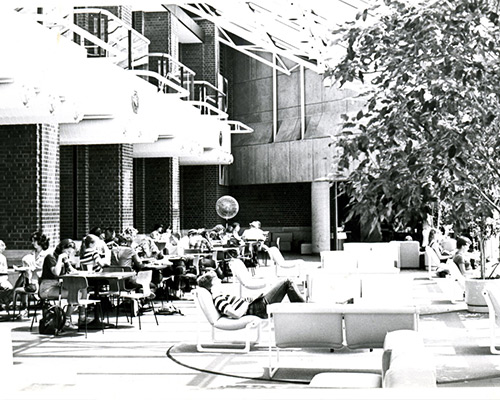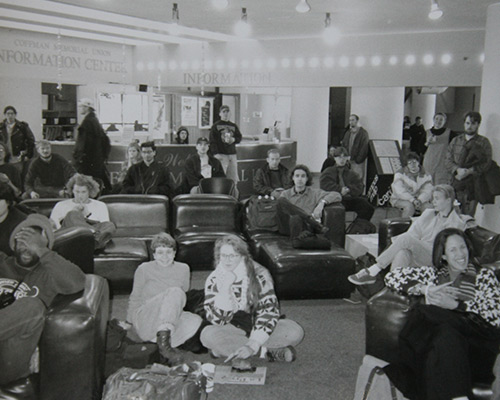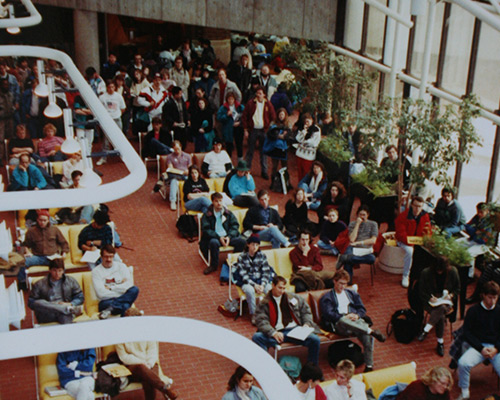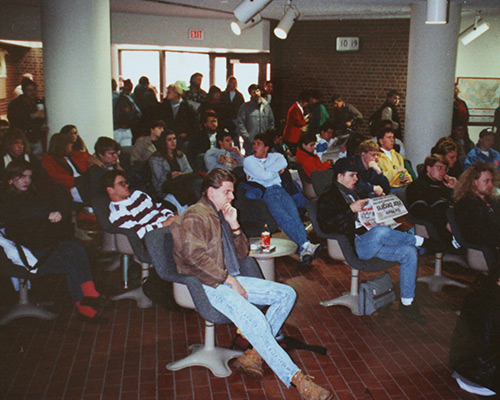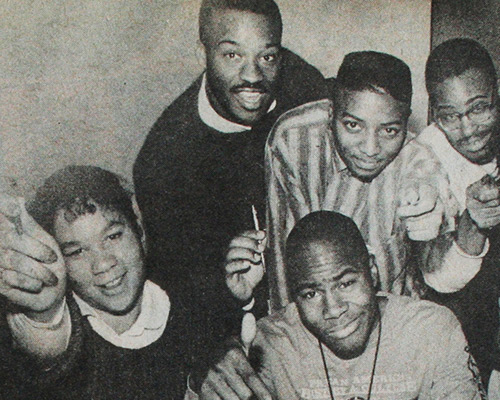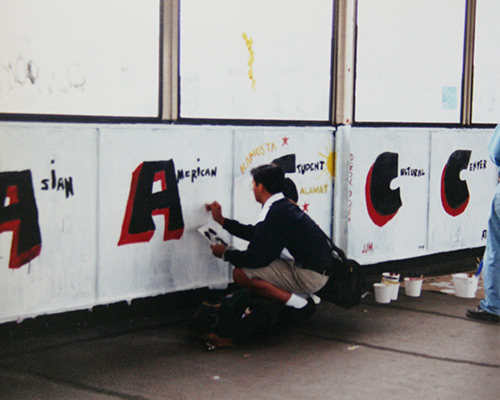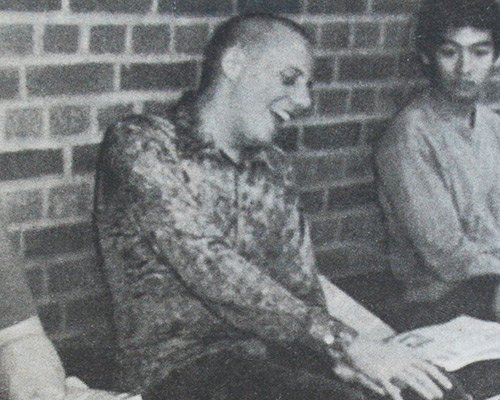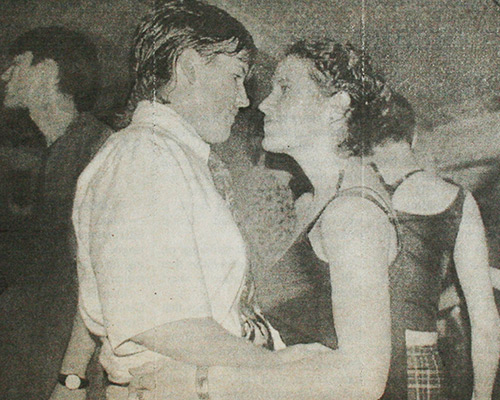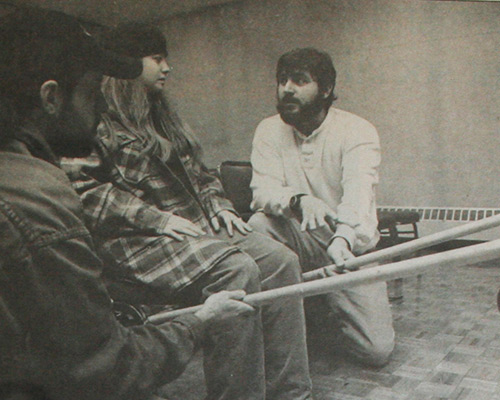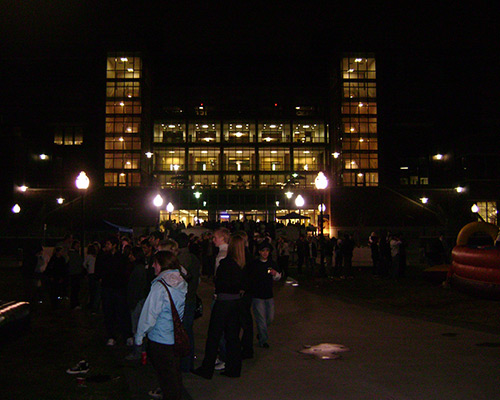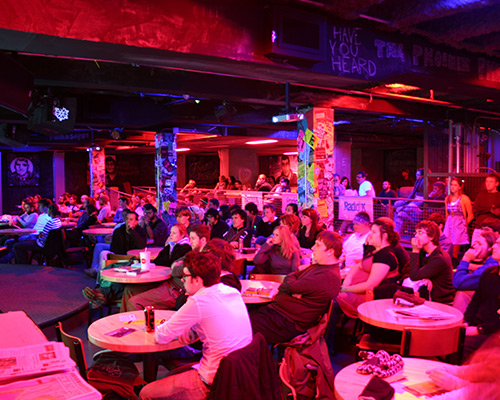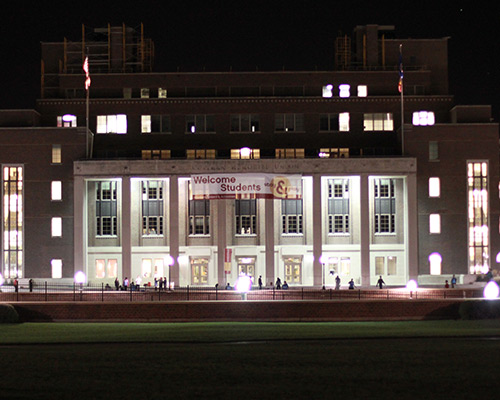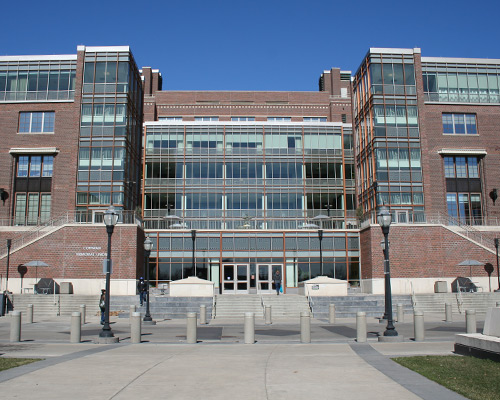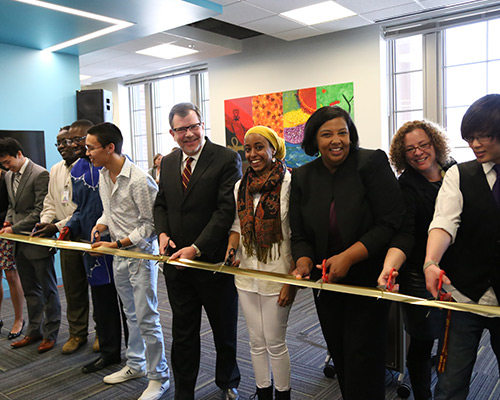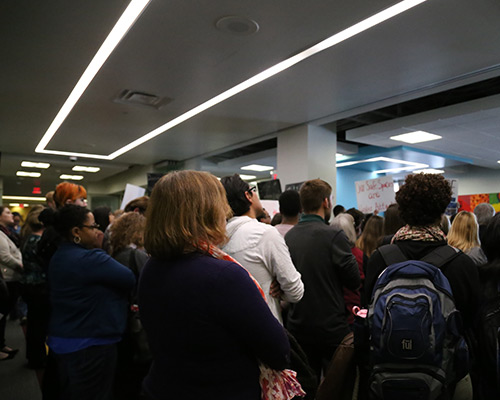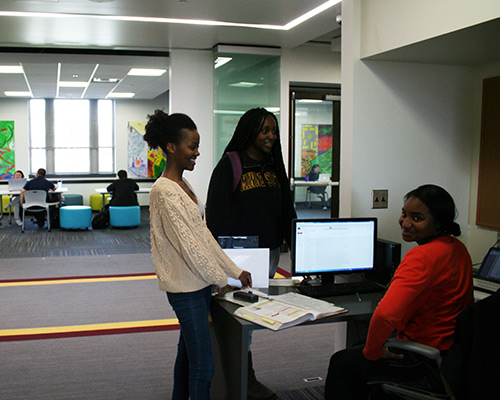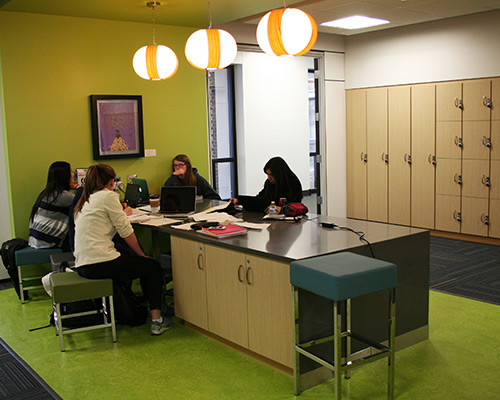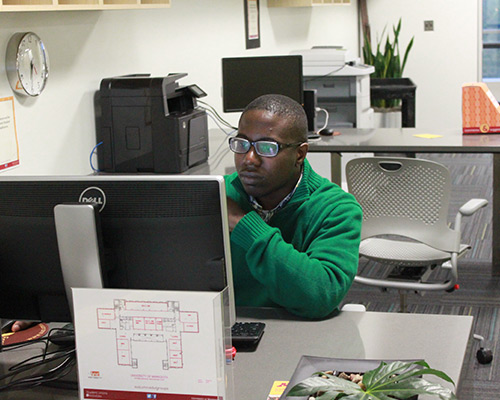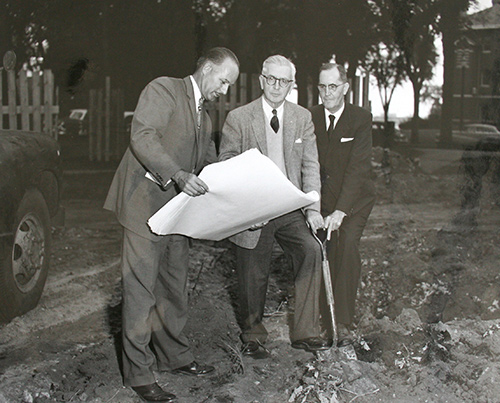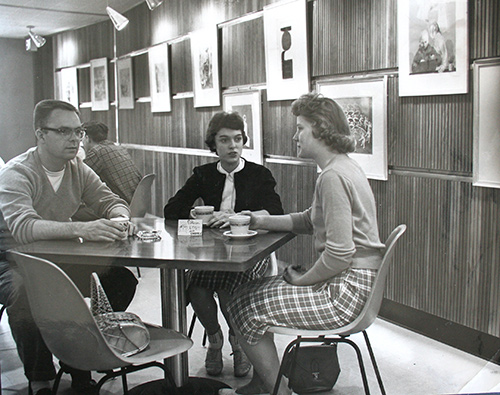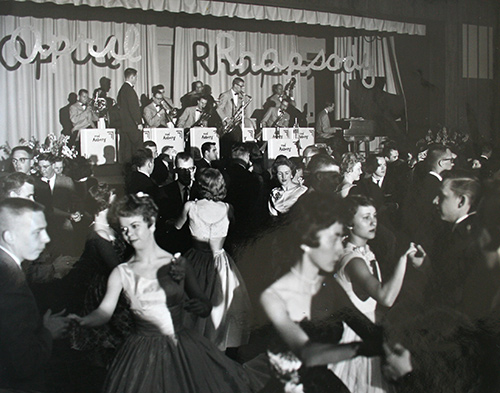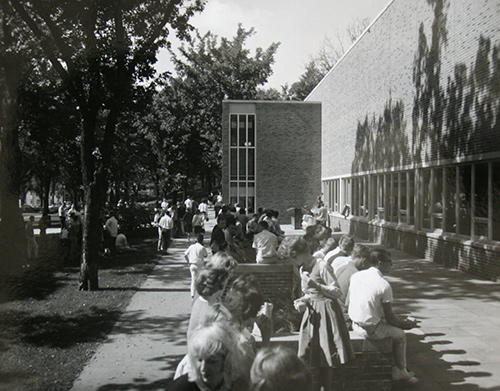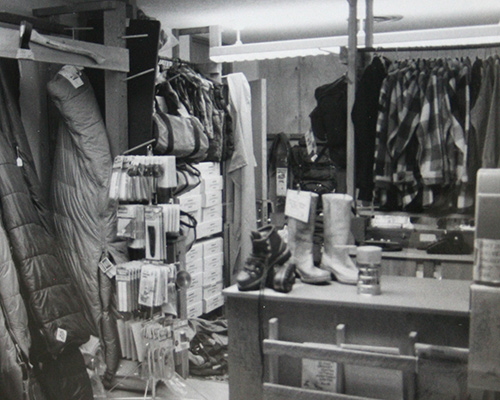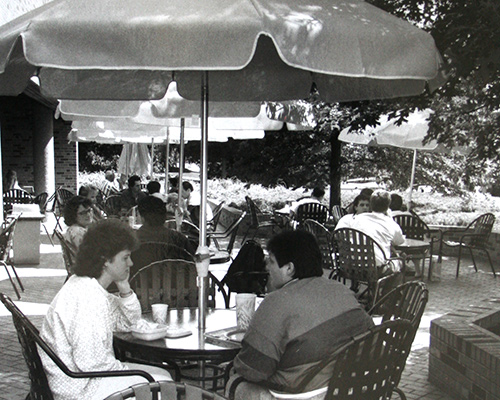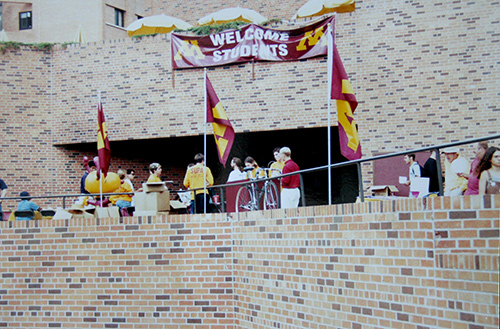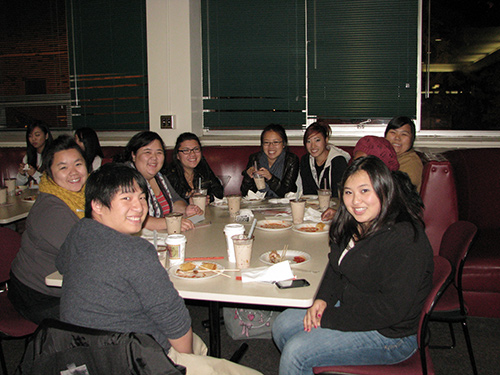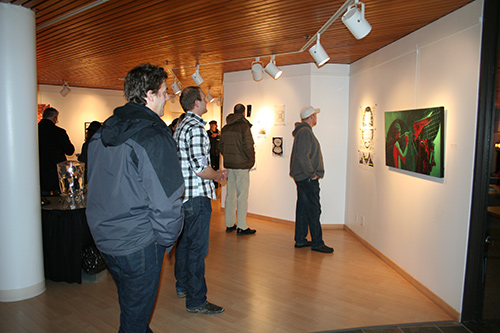Coffman Memorial Union
In 1936, University of Minnesota President Lotus Delta Coffman stated: “Someday, the University of Minnesota will have a student union as the center of its social life.” Construction for the student union Coffman had imagined began in 1939, a year after his death. Coffman Memorial Union opened its doors in time for classes in fall 1940. The building featured a ballroom that a accommodated up to 1,200 dancers, a two-story main lounge, a bowling alley with sixteen lanes, billiards, a barber and beauty shop, among many other amenities. Coffman Memorial Union underwent its first major renovation during the 1970s, which dramatically changed the building’s aesthetic. A second major renovation was completed between 1999 and 2003, which modernized the building but also honored the original design. In 2013, the second floor of Coffman Memorial Union was renovated to meet the needs of the growing student organizations on campus.
The 1940s
Coffman Memorial Union opened in time for classes in September, 1940 and was dedicated on October 25th as part of the Homecoming celebration.
An article in Time magazine claimed that the new union: "Rivaled the Hanging Gardens of Babylon." Exaggerations aside, Coffman did offer many amenities, but the Minnesota Alumni Weekly was quick to point out that there were unions across the United States that cost more, despite having smaller student bodies. According to the Alumni Weekly, the most important part of the union was not that it included many new facilities, but that having one large building was, “a symbol of University unification." Although Coffman did include separate men’s and women’s lounges, most of the spaces were open equally to men and women, which served to create a more unified community.
Coffman was not meant to be just a social space, but a place that would help shape students’ development and prepare them to be contributing members of society.
The 1950s
By the 1950s, Coffman Memorial Union was no longer a brand new building. In 1953, the director Gordon Starr wrote up a plan addressing the redesign of certain parts of the building and replacement of furniture that had been used heavily for thirteen years. Although expectations about how students were to use the building certainly differed from today, thousands of students naturally caused quite a bit of wear and tear. The uses of space in Coffman were more regulated than they are today. It was permissible to play cards only in the game room, students were allowed to eat food brought from home only in designated areas and, at least officially, studying was permitted only in areas dedicated to studying. To what degree it was possible to regulate the use of spaces is a separate issue.
The 1960s
Coffman Memorial Union was built to accommodate 14,000 students, but by 1960 there were almost 30,000 and enrollments continued to rise. As of the mid 1960s, as many as 20,000 students traipsed through Coffman during a single day. In a 1965 letter, director Gordon Starr emphasized that Coffman was the most used building on campus and that that there simply was not enough space available, writing in parenthesis that: “This is typified by one student who found it necessary to use a telephone booth to eat his lunch.” During the 1960s, attitudes toward how the spaces were used began to change, both due to a lack of available space and due to the belief that individuals from different backgrounds, disciplines and generations should be comfortable associating with one another.
1965 - 1975
The first protest of the Vietnam War at the University of Minnesota took place on February 2, 1965 in front of Coffman Memorial Union, and students staged protests at Coffman throughout the war. Students began occupying the building 24 hours a day starting on May 4, 1970, the day the National Guard killed student protesters at Kent State Demonstrations continued to occur. They occupied Coffman continually over the next month. The largest demonstrations at the university occurred two years later in May, 1972. On May 8, 1972 President Nixon announced that the U.S. was going to blockade and lay mines in North Vietnam’s harbors. May 10th, the most significant protests in the University of Minnesota’s history took place across campus. Protesters barricaded Washington Avenue, and 6,000 people gathered in front of Coffman to listen to various speakers, including the former U.S. Senator from Minnesota, Eugene McCarthy. When the renovation was completed in 1976, the redesign made it more difficult for large groups of students to assemble in the building.
The 1970s
Coffman Memorial Union’s first major renovation was completed between 1974 and 1976. The redesign substantially changed the building’s appearance and eliminated many of the Art Deco aspects of the original design. Some members of the community felt that there was a lack of consideration to the integrity of the original union. After the renovation, Coffman was unrecognizable from the building you see today. The main color scheme was changed to bright magenta, blue, yellow, orange, purple, and green. The front was glassed in to the pillars and one could enter the building only from the side. At the back of the building, one third of the terrace was covered in an angled glass, extending the Main Lounge, which was renamed the Ski-U-Mah Lounge. The redesign added about 25,000 square feet of space, but the added glass caused the building to heat up like a greenhouse in summer and leak heat in the winter.
The 1980s
When individuals who had attended the University of Minnesota in the 1980s were asked what they most remembered about Coffman Memorial Union, television was a common theme. As in previous decades (Coffman’s first television was purchased in 1948), during the 1980s Coffman’s television brought students together, as people did not carry their own personal screens with them everywhere they went. Phil Archer, a former University of Minnesota student and current staff member, recalled that: “People were glued to the TV in the old lounge when the Challenger space shuttle blew up in '86.” Gathering in public spaces provides a sense of solidarity during difficult times. Students also watched their favorite shows at Coffman. Teresa Schweitzer, who graduated from the University of Minnesota in 1987, remembered that there was always a big group of students watching Days of Our Lives.
The 1990s
Today, Coffman Memorial Union provides individual spaces on the second floor to nine cultural centers along with multi-uses space that are available to all student groups. Both the International Relations Bureau (today known as the Minnesota International Student Association) and the YWCA (Today Feminist Student Activist Collective) were granted space in Coffman in 1940. However, they were not categorized as cultural centers until the 1990s. The four groups that originally were understood as cultural centers were not granted space in Coffman until the 1990s. According to an article published in the Minnesota Daily on April 26, 1989: “After 12 years of occupying shabby rooms, run-down buildings and confined space, three university cultural centers may have finally found their niche.” The article goes onto say that the African, Asian-American and La Raza student cultural centers were to be allocated space in Coffman, which came to fruition in in the early 1990s, with the American Indian Cultural Center remaining in Jones Hall. Soon after, The Disabled Student Cultural Center and the group that later became known as the Queer Students Cultural Center also were provided with private space in Coffman. Al-Madinah was founded in 1999, the year that Coffman’s second major renovation began, and both Al-Madinah and the American Indian Cultural Centers requested— and were granted— space once renovation was completed in early 2003.
The 2000s
Coffman Memorial Union was closed from Monday November 15, 1999 until Tuesday, January 21, 2003 for a major renovation that removed most of the traces of the previous renovation . The redesign cost $71.5 million and honored the building’s intended aesthetic, but also was modernized to include important features such as air conditioning. Inside of Coffman, many of the original features, such as terrazzo floors and original light fixtures, reconnect the building with its roots. For many years, Coffman was the center of student life on campus and myriad students made use of the building every day, but over the years, traffic fell dramatically. The redesign brought students back through the doors, helping to make Lotus Delta Coffman’s vision a reality once again. Weekly late night programming also attracted students to visit Coffman on the weekends and provided students living in the residence halls with easily accessible activities.
The 2010s
In summer 2013, the second floor was renovated. The second floor houses the nine cultural centers along with student government, and Commuter Connection. The Second Floor Advisory Committee was established in 2011-2012 in order to guide the redesign and space allocation process and included representatives from the cultural centers, student government and groups without office space. The committee decided that it would be best to have the cultural centers on the sides and an open space in the middle so that student groups— including other cultural centers— without space on the second floor would be able to utilize the redesigned space. The multi-use space includes both open areas and smaller conference rooms that student groups can reserve for meetings. Individual students are also welcome to use unreserved spaces and the common area. The construction took place during summer 2013 and the second floor reopened in time for fall semester. While some students protested the redesign, cultural center representatives on the Second Floor Advisory Committee played a major role in directing the re-design process. Today the spaces are heavily utilized by students.
Lotus Delta Coffman
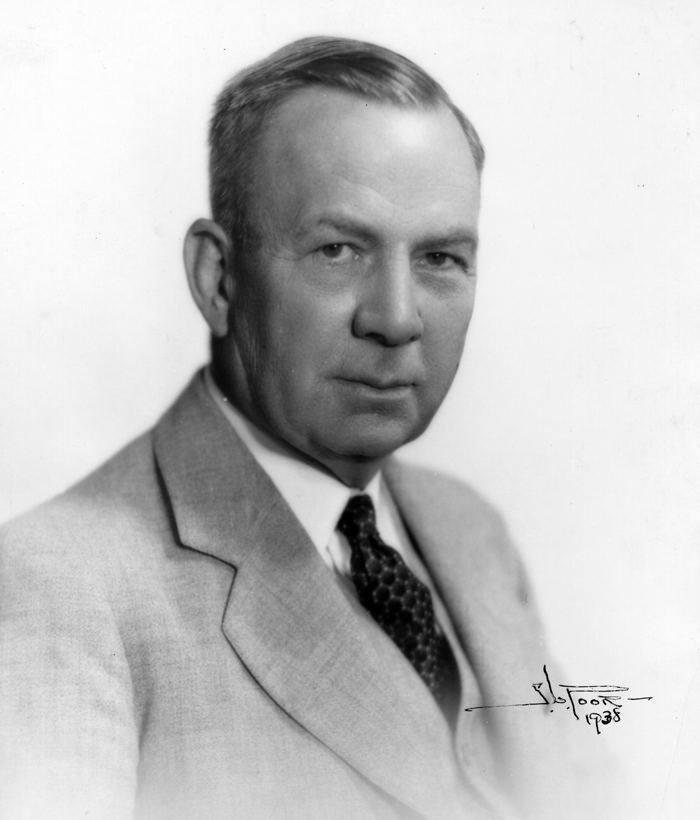
Lotus Delta Coffman
In 1936, University President Lotus Delta Coffman formed a special Student Union Committee, and it was with his support that the construction of a new co-educational Minnesota Union was made possible. President Coffman did in office in 1938, the same year that ground was broken for what would be Coffman Memorial Union.
West Bank Skyway
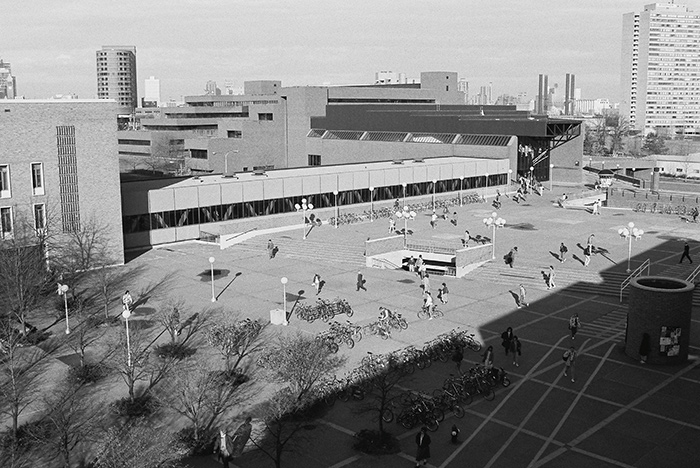
1962
West Bank Skyway
After the first buildings on the West Bank of the University of Minnesota were constructed in 1962, the West Bank Union was established. The West Bank Union was administered independently and had its own Board of Governors, like the other three existing student unions. The West Bank Union was a decentralized union which developed in conjunction with the rest of the West Bank campus. The construction of a dedicated union facility on the West Bank was discussed, but never carried out. However the creation and maintenance of the West Bank Skyway was heavily influenced by the efforts of the student union board. The skyway was once referred to by the board as the West Bank Connecting Link. Its construction was completed in September of 1980. In early spring of 2005, the West Bank Skyway closed for renovations and reopened August 15th of that same year with new floors, fresh paint, better lighting and an open atmosphere. The Gopher Express West convenience store of Student Unions & Activities still provides services in this location today.
St. Paul Student Center
The St. Paul Student Center (SPSC) opened in 1959 and is located across the street from Coffey Hall, where the original Ag Union was located. SPSC was built to serve the student population on the St. Paul campus, which was significantly smaller than the population on the Minneapolis campus. Construction started in 1958 and by December of 1959 a few sections of the union were completed and occupied. The St. Paul Student Center was completed in 1960 and underwent a major renovation from 1978 to 1980 to double its space.
1957
Groundbreaking
On September 15, 1957 University officials broke ground for the construction of the St. Paul Student Center. In the spring of 1959 the building partially opened. Total cost for constructing the building in totality came to $1,150,000.
1959
The St. Paul Student Center became a common gathering space for students and since then has served the community through student group programming and activities.
The 1960s
North Star Ballroom
In the 1960s the North Star Ballroom became popular for a variety of large scale student group dances. Today the space, in addition to the theater, is widely used by the community, campus departments, and student groups for a myriad of cultural events and special events.
The 1960s
Students are pictured here lounging in front of the St. Paul Student Center prior the 1978 renovation. The renovation gave the front of the St. Paul Student Center a completely new look, which included a series of different entrances and a new outdoor terrace area.
The 1970s
The Outdoor Store was a popular commodity into the early 2000s. It eventually become known as the Center for Outdoor Adventure (COA). The store closed when the COA program moved to the Department of Recreational Sports.
The 1980s
Students are pictured enjoying the new outdoor spaces of the St. Paul Student Center, as a result of the 1978-1980 renovation.
The 1990s
SUPA
With the closing of Coffman Union (for renovation purposes) in the late 90s, the St. Paul Student Center became the main alternative gathering space for the Student Union programing board, which was once known as SUPA (Student Unions, Programs and Activities).
The 2000s
In the mid-2000s, a late night program known as Gopher’s After Dark became so popular in Coffman Union, that many programs also began to be offered in the St. Paul Student Center.
The Gopher Spot and it’s bowling alley were also remodeled during this time-period providing greater opportunities for programming initiatives and better food options.
The 2010s
Students are pictured here at the Paul Whitney Larson Art Gallery, which is located on the lower level of the St. Paul Student Center. Paul Whitney Larson was the director of the St. Paul Student Center from from 1959 to 1979. In 1980 the gallery was named in his honor. Since then student leaders have actively been promoting the space with art exhibits featuring works by students, departments, the local community, and international artists.
Village Union
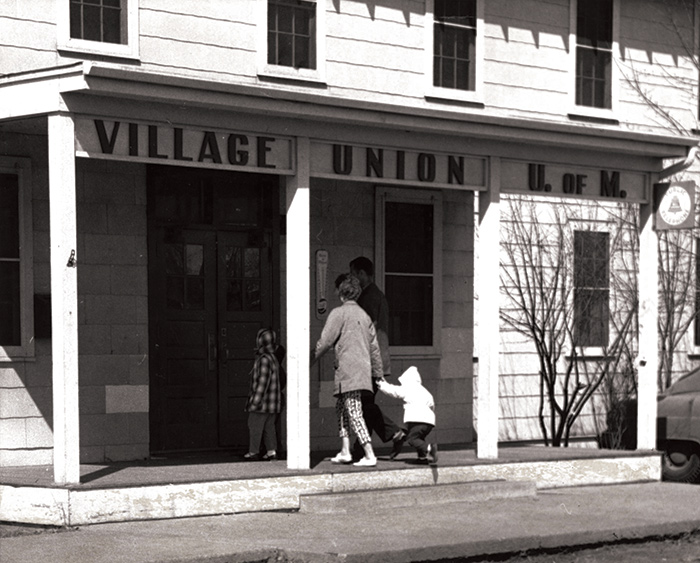
1940s
Village Union
By the time Coffman Memorial Union opened in 1940, discussions of a new union facility for the St. Paul campus were already underway. However, before a new student union facility was built on the St. Paul campus proper, a third student union opened on the Twin Cities campus, at University Village. University Village was a temporary housing settlement established to accommodate the influx of World War II veterans attending the University thanks to the G. I. Bill of Rights (1944). Many veterans were married with children and needed a place where they could live with their families. The University Village Union opened in 1948 in a converted barrack. Its mission was to serve the needs of student veterans and their families. The University Village Union had its own governing board and specialized in programs geared toward young married couples and their children. The University Village Union closed in 1964.
Farm Union
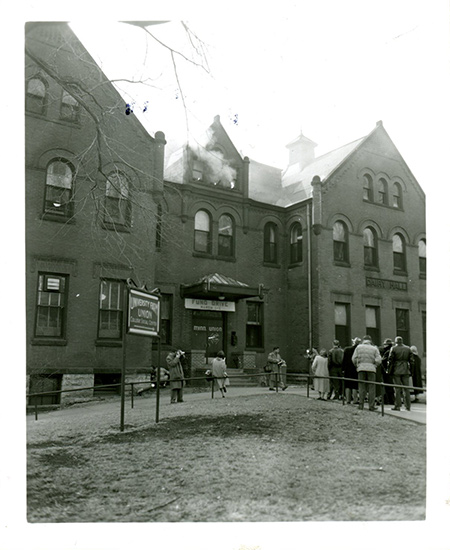
1916
Ag Union
In 1916, the Minnesota Union Board of Governors decided to establish a branch of the Minnesota Union at the agricultural campus in St. Paul. The Ag Union originally was housed in an administrative building, but by 1925 was located in Old Dairy Hall, which was razed in 1960, the year after the St. Paul Student Center opened.
Nicholson Hall
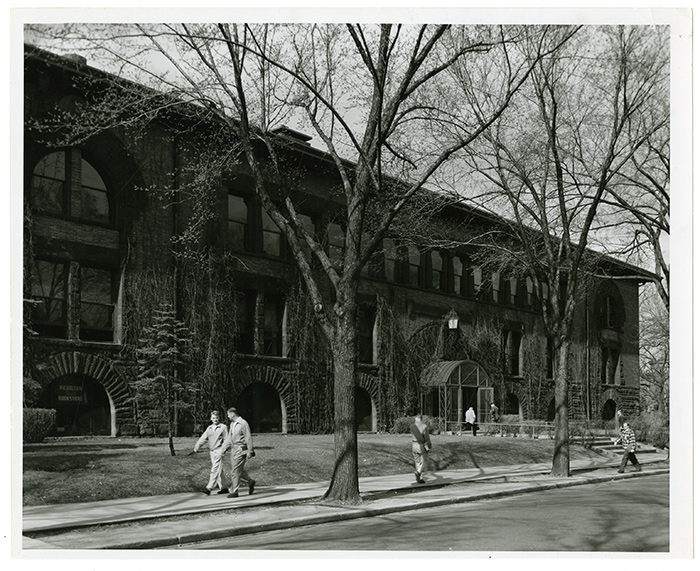
1914
Nicholson Hall
In 1908, the Minnesota Union was formed to represent all men at the university. In 1914 the chemistry building was converted to a gathering space for men, providing the Minnesota Union with a physical space. The building included a smoking room, game rooms, and two billiards rooms. Like Shevlin Hall, it provided men with a place to eat, study, and engage in social activities, but was fundamentally different in that it was modeled after gentlemen’s clubs. The building later was renamed Nicholson Hall, and currently is home to a variety of academic departments.
Shevlin Hall
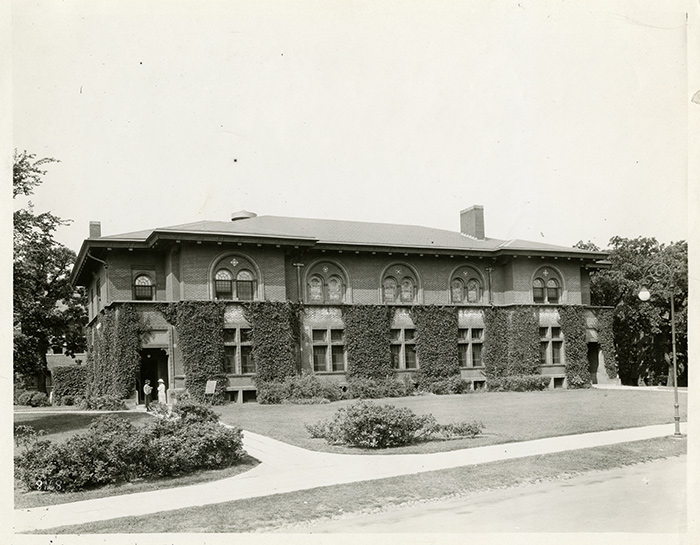
1906
Shevlin Hall
In 1906, the women’s building, Alice Shevlin Hall, was the first student building to open at the University of Minnesota. The building provided women with basic amenities like restrooms along with a space where they could engage in intellectual and social pursuits. Today Shevlin Hall is home to the Department of Speech-Language-Hearing Sciences.


